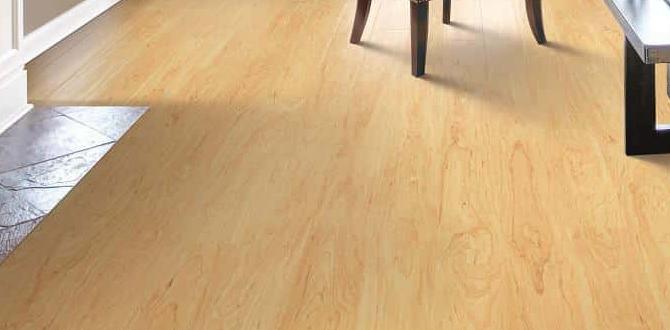Quick Summary
Installing baseboards yourself is an effortless DIY project! With the right tools and this simple guide, you can achieve professional-looking results that transform your room. We’ll show you easy measuring, cutting, and fastening techniques, even for beginners wanting to use a nail gun.
Hey there, DIYers! Jack Shaffer here, your go-to guy for all things nail guns and woodworking. Ever looked at your walls and thought, “Something’s missing”? Chances are, it’s baseboards! Those often-overlooked trim pieces do a fantastic job of hiding gaps between your walls and floors. But let’s be honest, the thought of installing them can feel a bit daunting, especially if you’re new to home improvement. You might be worried about tricky cuts or getting a perfectly smooth finish. Well, breathe easy! I’m here to tell you that installing baseboards is totally achievable, and with a little know-how, it can be downright effortless. We’ll break it down step-by-step, covering everything from choosing your trim to making those final, satisfying nails go in straight. Ready to give your rooms that finished, polished look? Let’s get started!
Table of Contents
Why Add Baseboards? The Finishing Touch Your Room Deserves
Baseboards are more than just a decorative element; they’re the unsung heroes of interior finishing. They cover that critical joint where your wall meets your floor, a space that can otherwise be a magnet for dust, drafts, and unsightly construction gaps. A well-installed baseboard instantly makes a room feel more complete and polished. Think of it like the perfect frame for a beautiful picture – it elevates the entire space. Plus, they offer a little protection against scuffs from vacuum cleaners and everyday bumps.
Beyond aesthetics and function, adding baseboards can also increase your home’s perceived value. It’s one of those finishing touches that speaks to attention to detail. If you’re looking to refresh a room without a major renovation, new baseboards are a highly effective and budget-friendly way to make a big impact. You’ll be surprised at how much of a difference they make!
Tools and Materials: Gearing Up for Success
Before we dive into the “how-to,” let’s make sure you have everything you need. Having the right tools on hand makes the job go so much smoother and safer. For this project, I’m a big fan of using a nail gun, especially a brad nailer or finish nailer, because it makes the process much faster and more professional-looking than using a hammer and nails. Safety first, always!
Essential Tools:
- Measuring Tape: For accurate measurements. A 25-foot tape measure is usually a good all-around choice.
- Pencil: To mark your cuts and measurements.
- Miter Saw: This is your best friend for cutting baseboards at the perfect angles. A manual miter box and hand saw can work, but a power miter saw makes it much easier and more precise. For more on choosing the right saw for DIYers, check out Popular Mechanics’ guide to the best miter saws.
- Nail Gun: A 16-gauge or 18-gauge finish nailer or brad nailer is ideal. Make sure you have the proper nails for your nail gun.
- Air Compressor (if using a pneumatic nail gun): And the hose to connect it.
- Safety Glasses: Absolutely non-negotiable. Always protect your eyes when cutting or nailing.
- Work Gloves: To protect your hands.
- Stud Finder: To locate wall studs for secure fastening.
- Caulking Gun and Paintable Caulk: For filling small gaps and nail holes.
- Wood Filler or Spackle: For filling nail holes before painting.
- Sandpaper (medium and fine grit): For smoothing imperfections.
- Optional: Wood Glue: For reinforcing mitered corners.
Materials You’ll Need:
- Baseboards: Choose your preferred style and material (wood, MDF, PVC). Measure your room’s perimeter and add about 10-15% extra for cuts and mistakes.
- Nails: Size and type appropriate for your nail gun and baseboard thickness.
- Primer and Paint (if painting): Or stain and sealant if finishing natural wood.
Choosing Your Baseboard Style: Aesthetics Meet Function
The world of baseboards offers a lot of variety! Your choice can dramatically affect the look and feel of your room. Think about the architectural style of your home and the furniture you have. For modern homes, a simple, clean profile might be best, while older homes often suit more ornate, traditional designs.
Here are some common types:
| Type | Description | Best For |
|---|---|---|
| Colonial | Has a curved or rounded top edge, often with decorative molding. | Traditional and historical homes. |
| Ranch | A simpler, flatter profile, often with a slight bevel at the top. | Modern, minimalist, and ranch-style homes. |
| Craftsman | Taller and wider than other types, with a flat face and square edges. | Craftsman-style homes, or for a bolder statement. |
| Cali Baseboard | A modern style with a shadow line or curve for a sleek look. | Contemporary and minimalist interiors. |
| MDF (Medium-Density Fiberboard) | Engineered wood product, very stable, easy to paint, and cost-effective. Can be damaged by moisture. | Interior rooms where moisture isn’t a concern. |
| Solid Wood | Classic choice, durable, can be stained or painted. More expensive. | Anywhere you want a high-quality, natural look. |
When selecting, consider the height. Standard baseboards are usually between 3 ¼ inches and 6 inches tall. Taller ceilings can often handle taller baseboards, which can make a room feel more grand. Make sure the thickness is also appropriate for your room and preference.
Measuring and Planning: The Foundation of a Flawless Finish
This is where we lay the groundwork for a perfect installation. Take your time here, and you’ll prevent headaches later. Accuracy is key!
How to Measure Your Room
- Walk the Perimeter: Start in one corner and measure the length of each wall.
- Note Doorways and Openings: Measure the width of each doorway, archway, or other opening that the baseboard will NOT run across. You’ll subtract these measurements from your total wall length.
- Record Your Numbers: Write down the length of each wall and subtract the widths of all openings. Sum your wall lengths and subtract the total opening width to get your total linear footage needed.
- Add for Cuts and Waste: As I mentioned, always add 10-15% to your total linear footage. This accounts for the angles you’ll cut on corners and any mistakes you might make. It’s much better to have a little extra trim than to run out midway through the job!
For example, if your walls measure 10 ft, 12 ft, 15 ft, and 13 ft, and you have a 3 ft doorway, your total wall length is 50 ft. Subtracting the doorway (50 – 3 = 47 ft), you’d need at least 47 ft of baseboard. Adding 15% waste (47 x 0.15 = 7.05 ft), you’d want to purchase around 54-55 linear feet of baseboard.
Planning for Obstacles
Think about windows, doorways, and any built-in features. You’ll need to plan your cuts carefully around these. For longer walls, you might need to join two pieces of baseboard. We’ll cover how to do that seamlessly later.
Cutting Baseboards: Mastering the Angles
This is where the magic happens, and where your miter saw really shines. The key to baseboards fitting snugly in corners is making the correct angled cuts. The most common angles are 45 degrees for inside and outside corners, but this can vary slightly depending on the exact construction of your walls.
Inside Corners
For an inside corner (where two walls meet to form an inner angle), you’ll cut two pieces of baseboard that meet in the middle. Each piece needs to be cut at a 45-degree angle, pointing away from the corner. Imagine your baseboard piece. The longer side of your cut will be the side that faces the room.
- Set your miter saw to 45 degrees.
- Place a piece of baseboard against the saw’s fence.
- Position the baseboard so the cut will angle away from the inner corner. For an inside corner, this means the blade will cut from the back-facing edge towards the front-facing edge.
- Make the cut. Repeat for the other wall, ensuring the two cut ends meet perfectly in the corner.
Outside Corners
For an outside corner (where two walls meet to form an outer angle), you’ll do the opposite. Here, the two pieces of baseboard butt up against each other, with the 45-degree cuts angled towards the corner. The longer side of your cut will be the side that faces the wall.
- Set your miter saw to 45 degrees.
- Place a piece of baseboard against the saw’s fence.
- Position the baseboard so the cut will angle towards the outside corner. For an outside corner, this means the blade will cut from the front-facing edge towards the back-facing edge.
- Make the cut. Repeat for the other wall, ensuring the two cut ends meet perfectly at the outer corner.
Joining Baseboards (Butt Joints)
You’ll almost always need to join pieces on longer walls. To make this joint less noticeable, you’ll use a scarf joint or a coping joint. A scarf joint is a type of butt joint where the two pieces are cut at an angle (usually 45 degrees) and then overlapped. This distributes the connection over a larger area, making it stronger and less visible than a straight butt joint. A coping joint is more advanced and involves cutting one piece to fit the profile of the other, often used for inside corners with uneven walls.
Let’s focus on the scarf joint for simplicity:
- Cut the first piece of baseboard to length, ending at your desired join location. Make a 45-degree cut.
- Cut the second piece of baseboard, also at a 45-degree angle, but in the opposite direction so that when you hold them up, they can overlap.
- Measure from the long point of this second piece’s cut to the end of the board. This is where you’ll make the join.
- You can add a bit of wood glue to the angled surfaces for extra strength before butting them together.
- Most importantly, ensure the joints land over a wall stud whenever possible for maximum stability.
Tip: It’s often easier to cut your baseboards by measuring the wall length and then making your angled cuts on the piece. For inside corners, measure from the corner to the end of your cut. For outside corners, measure from the corner to the outermost point of your cut.
Installing Baseboards: The Moment of Truth
Now for the fun part – attaching those beautiful new baseboards to your walls! This is where your nail gun really speeds things up.
Step-by-Step Installation with a Nail Gun
- Preparation is Key: Ensure your walls are clean and the old baseboards (if any) are removed. If you’re painting or staining, it’s often easier to paint/stain the baseboards before installing them, especially if they have intricate profiles.
- Find the Studs: Use your stud finder to locate the wall studs. Mark their centers lightly with a pencil. This is crucial for securely attaching the baseboards. You want at least one nail into a stud for every piece of baseboard. For more on finding studs, This Old House has some great tips.
- Start in a Corner: Begin with an inside or outside corner. Place the first baseboard piece against the wall, ensuring the bottom edge is flush with the floor and the top edge is where you want it.
- Nail it In: Hold the baseboard firmly in place. Using your nail gun, drive nails through the baseboard and into the wall studs. Aim for a nail every 16-24 inches, and always try to hit a stud. Also, drive a few nails into the top and bottom plates of the wall framing if possible. When joining pieces, ensure at least one end of the joint is secured to a stud.
- Angle Matters: Drive your nails at a slight angle (about 10-15 degrees) to maximize holding power, especially into studs. This helps prevent the nail from blowing through the face of the trim.
- Work Your Way Around: Continue cutting and fitting each piece, working your way around the room. Carefully measure and cut each new piece to fit snugly against the previous one and into the corners.
- Trimming Around Obstacles: For windows and doors, you’ll typically miter the baseboard to meet the casing. Often, this involves a 45-degree miter cut on the baseboard that turns away from the corner, meeting the vertical trim.
- Check Your Fit: As you go, periodically step back and look at the overall appearance. Ensure the gaps are small and the lines are straight.
Nail Gun Safety Note: Always read your nail gun’s manual. Never point it at yourself or others. Keep your fingers away from the trigger and muzzle. Ensure the air pressure is set correctly for the type of wood and nails you’re using.
What If I Don’t Have a Nail Gun?
No problem! You can absolutely install baseboards with a hammer and finishing nails. It just takes a bit more patience and elbow grease. You’ll want to use a nail set to drive the nails slightly below the surface of the wood, creating a small dimple for filling later. Aim for the same spacing and support into studs as you would with a nail gun.
Finishing Touches: The Professional Polish
You’ve installed the baseboards – fantastic job! Now, let’s make them look like a pro did them.
- Fill Nail Holes: Use wood filler or spackle to fill every nail hole. Press the filler in firmly and smooth it off with a putty knife. Let it dry completely according to the product instructions.
- Caulk Gaps: Apply a thin bead of paintable caulk along any small gaps between the top of the baseboard and the wall, and between the bottom of the baseboard and the floor (if you have a small gap there). Use a damp cloth or your finger to smooth the bead for a clean line. This hides imperfections and makes the trim look like a seamless part of the wall. For best results, use a high-quality paintable caulk.
- Sand Smooth: Once the filler and caulk are dry, lightly sand any rough spots or excess filler. Start with medium-grit sandpaper and finish with fine-grit for a super smooth surface. Wipe away all dust with a tack cloth or damp rag.
- Prime and Paint/Stain: Apply a coat of primer. Once dry, apply your chosen paint color or stain and topcoat. Two thin coats of paint are usually better than one thick one.
Taking the time for these finishing steps makes a massive difference in the final, professional look of your baseboards. It’s these details that truly transform a DIY project into a masterpiece.
Frequently Asked Baseboard Questions
Q1: How do I install baseboards around curved walls?
A: Flexible baseboards, often made of PVC or rubber, are designed for curved walls. For wood, you might need to make many relief cuts on the back of the board to allow it to bend, or consider a custom solution.



